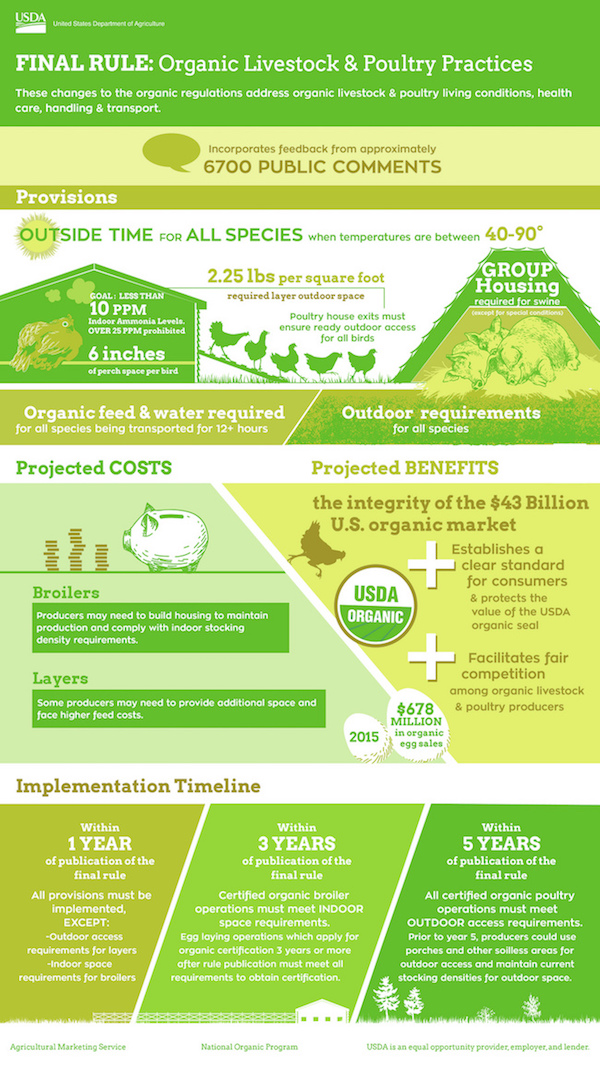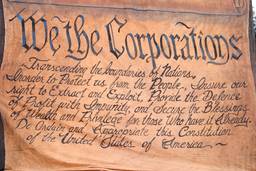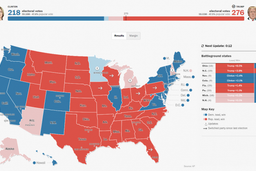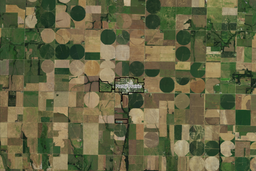Farm Policy Watchdog Stands by Organic Farmers. Will Secretary of Agriculture Perdue?
John Collins
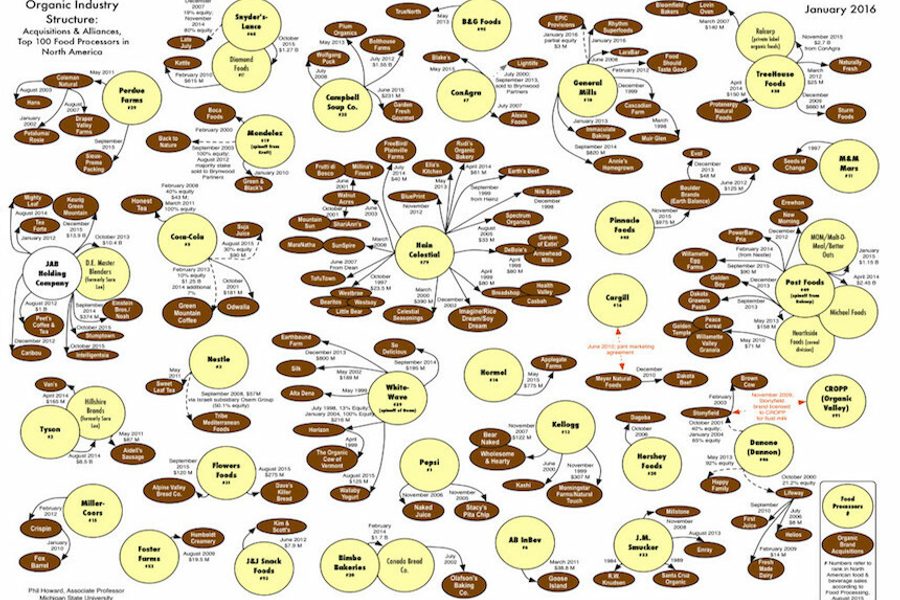
In the United States, demand for organically produced fruit, vegetables, meat, milk and eggs continues to grow. According to the Department of Agriculture (USDA), organic products are now being sold in three out of four conventional grocery stores. In 2015, organic food sales reached $43.3 billion — a new record, but one that’s expected to be surpassed (again) as soon as 2016 consumer data is tallied and released.
This steady increase in demand for minimally-processed “real food” — pesticide-free greens and meat from livestock who spent at least some of their lives outside eating plants — has not gone unnoticed by the nation’s largest conventional food companies. In order to capitalize on the organic trend without massively restructuring their core enterprises, food and beverage corporations have responded by acquiring dozens of smaller organic brands to market alongside their staples. Naked Juice, Van’s and Annie’s Homegrown, for example, are owned by Pepsi, Tyson and General Mills respectively. Often lost in the ensuing marketing wars are the values that started the local, sustainable food movement in the first place — a widely perceived need for systemic change that includes, but also goes far beyond, the rejection of pesticides.
Matthew Hoffman, a researcher, organic farmer, author and Fulbright Scholar, has spent the last 20 years involved in sustainable agriculture. In a recent essay (published here on the Greenhorns Irresistible Fleet of Bicycles blog) Hoffman makes the case that, while hydroponically produced food may well be an important part of food production now and in the future, the method should not be considered organic…or even agriculture. He also recaps how organics became part of a larger call for ecological sustainability and economic sanity:
As a movement, sustainable agriculture is a reaction against modern agriculture’s tendency to do away with the complex natural processes and relationships on which farming used to depend.
The essential difference lies not in any particular set of techniques, but in the way the different systems are organized. In the past, for example, plants and animals were raised in the same place and fertility was returned to the soil in the form of animal manure. Today, animals are kept by the thousands in large buildings in some parts of the country, where their waste becomes a problem, while other parts of the country are transformed into endless miles of corn, treated with synthetic fertilizer that pollutes the waterways. In both places, countryside and country life disappear.
The purpose of sustainable agriculture — viewed as a system, rather than a set of techniques — is to reorganize production in a way that maintains healthy rural landscapes and healthy communities. Organic farming practices are an important part of this broad project.
Hoffman makes some important points. First, understanding and respecting how nature works was not always a radical concept. Somewhere down the line, the pursuit of endless economic growth required putting profits ahead of healthy food, meaningful work, land stewardship, water protection, animal welfare, resilient communities, local economies etc. And the “civilized” world fell for it.
The sustainability movement, of which organic agriculture is one part, formed in direct response to the compounding toll this system is taking not just on the environment, but on human health and the quality of our disconnected daily lives. Like changing how we generate energy, sustainable agriculture faces an immense set of built-in challenges and threatens the established order. Today, our hopes for a viable alternative food system are contingent upon the continuing economic success of small organic farms. Part of that success will increasingly involve protecting consumer trust in the integrity of the organic label.
Defining and defending what “organic” means
The National Organic Program (NOP), part of the USDA’s Agricultural Marketing Service, is responsible for developing national standards for organically-produced agricultural products. They’re also responsible for establishing international organic import and export polices as well as investigating and enforcing reported violations of the regulations they develop. According to the NOP, their standards “assure consumers that products with the USDA organic seal meet consistent, uniform standards.” High NOP standards are good for the organic community. It’s in Big Food’s best interest to lobby to keep USDA’s interpretation of “organic” as loose as possible. Occasionally, brands with earthy sounding names (packaged to conjure bucolic images in the minds of metropolitan grocery shoppers) are not what they appear to be.
Enter the Cornucopia Institute, a non-profit, organic agriculture resource center based in Cornucopia, Wis., that advocates on behalf of agricultural policies that make sense for small-scale farmers while protecting the sincerity of the organic designation. In addition to providing consumers with food company scorecards and updates on national farm policy, the Institute acts as an organic industry watchdog. Their mission is to “protect ethical, family-scale farms from unfair competition and to protect organic eaters so that they can have confidence in the safety and authenticity of their food.”
Farmer Mark Kastel, the Institute’s co-founder and Senior Farm Policy Analyst, puts it this way: “Cornucopia is adamantly nonpartisan, supported by a diverse membership. We all unite in the conviction that shifting to ecological agricultural practices, and eating the very best food, pays dividends for our families, especially our children, and society as a whole.” Below, excerpted from a recent Cornucopia update, Kastel explains why last minute Obama administration changes to animal welfare farm policy were “too little, too late” and he explores what Trump’s pick for secretary of agriculture, Sonny Perdue, might mean for organics.
Uncharted waters
Perdue’s perspective on organic food and agriculture is a mystery; he has never publicly spoken about it.
During his campaign, President-elect Trump expressed his disdain for federal regulations and vowed to relieve regulatory burden on businesses. So how will this apply to the National Organic Program (NOP) at the USDA? The most conservative faction in Congress, the Freedom Caucus, has suggested eliminating the NOP.
The NOP was established by an act of Congress, the Organic Foods Production Act of 1990. The organic community — farmers and consumers — actually asked Congress for strict regulation. We wanted the organic label to mean something!
Ever since, large agribusiness, agrochemical and biotechnology interests like Monsanto, have been doing their best to discredit organics and have appealed to politicians to pull the plug.
In the meantime, organics has grown into a more than $40 billion a year industry. Many organic brands have been purchased by major corporate food interests represented by their own lobby group, the Organic Trade Association (OTA). Corporate interests have done their best to expand and weaken the working definition of organic so it fits their industrialized food growing and processing practices.
Which powerful lobbying faction in Washington will win out? Or will the swamp truly be drained at the NOP and, once again, will the “people’s” interests be respected and protected?
On the Obama administration’s last minute changes to organic policy…
During its final days, the Obama administration published two exceedingly controversial rulemaking initiatives as gifts to the OTA and business lobby. First, over the objection of certified organic farmers, they have paved the path for a proposal from corporate lobbyists to tax farmers and other participants in the organic industry to pay for promotion and research (commonly called the organic check-off). Then, on Jan. 18, after a years-long delay the USDA published a final rule purportedly improving organic animal welfare. But unlike Europe, where organic chickens are required to have access to 43 ft² outdoors, the USDA’s anemic rule only requires 2 ft² outdoors and as little as 1 ft² indoors. Even that is too much for the largest corporate factory livestock operators. Senate Agriculture Committee Chairman Pat Roberts (R-Kan.) has told the Associated Press he will work with President Trump to reverse the rule.It was also announced in the waning days of the Obama administration that USDA Secretary Thomas Vilsack resigned to take a lucrative job leading the U.S. Dairy Export Council, a position that paid $800,000 last year. Ethics questions are surfacing as Mr. Vilsack, characteristically, passes through the “revolving door” after his agency approved five or six million dollars last year for the Export Council.
To view the USDA’s latest Organic Livestock and Poultry Practices ruling, click here. (Image: usda.gov)
Cornucopia’s list of things to do
It’s the changing of an era in the White House and at the USDA, and Cornucopia will continue to carefully monitor and report on the agency’s activities on behalf of all organic industry stakeholders. We will engage with the new Trump/Perdue administration in an attempt to:
1. Spark vigorous enforcement cracking down on confinement of organic dairy cows, beef cattle, laying hens, and other livestock in industrial settings. Lack of enforcement has disadvantaged ethical family farmers and betrayed consumer trust — an endemic problem during both the Bush and Obama administrations.
2. Seek a vigorous investigation, and ongoing oversight, of vast amounts of organic animal feed and food ingredients being shipped to the U.S. from China and other non-reputable sources.
3. Reverse the arbitrary and capricious power grab (now the subject of federal lawsuits) that have undermined the authority of the National Organic Standards Board (NOSB), the panel Congress set up to buffer organic regulations from corruption by corporate lobbyists. (Background: The NOSB is a 15-person advisory committee that makes recommendations to the USDA regarding organic food and products. Members are appointed by the secretary of agriculture to serve a five-year term. It is of the utmost importance that seats on this board are filled by actual organic farmers — not industry executives masquerading on behalf of sustainable family-sized farms. In 2016, the Cornucopia Institute filed suit against the USDA for its appointment of two individuals with industrial agribusiness ties on grounds that Congress has reserved those seats for organic farmers.)
4. Encourage the USDA to keep its Obama/Vilsack’s promise to ban conventional replacement animals that are facilitating the expansion of giant factory dairies. (Background via Ag Weekly: “The department’s National Organic Program has been accused of facilitating the expansion of “factory farms” producing organic milk, meat and eggs through the agency’s lax enforcement of existing regulations… Some large industrial-scale dairy operators sell all their baby calves at birth and replace them with conventional animals that have been raised on conventional/GMO feed, antibiotics and other drugs banned in organic production.”)
5. Seek enforcement action banning the illegal labeling of soilless (hydroponic) produce as organic. (You can also read: “Do We Want Organic Agriculture, Or Just Organic Food?” by Matthew Hoffman @ Cornucopia News.)
Let’s see what happens when farmers (not Big Food) decide what federal farm policy looks like
Nobody’s asking (rather, expecting) Sonny Perdue’s USDA to start throwing federal wrenches into the gears of the global food machine. (See: “Trump Nominates a Secretary of Agriculture (and, No, It’s Not Wendell Berry)”) However, in voting for Donald “the regulation slayer” Trump, millions of Americans — including plenty of farmers — are expecting to see their wellbeing conspicuously placed above the already wealthy and powerful.
Farming commands respect. Farmers have a long history of rising to the task of doing what it takes to keep the rest of us alive and well. Factory farms have a much shorter history of doing the opposite. Year after year, as demand for organic food grows, a compelling economic case is being made for doing that which is also ecologically responsible. Sustainable farmers in rural America who are doing the hard work for the right reasons deserve all the support they can get.
Small farms are small businesses, but they are uniquely out-sized, out-funded and politically out-gunned when it comes to facing off against their corporate counterparts. As Trump rides in on a wave of executive orders, promising trade deals that will put an end to the Obama administration’s so-called war on prosperity, he better make sure the regulations he’s rolling back are not just special interest handouts that end up making it even harder for small businesses to compete.
Come to think of it, what’s the status of that Bayer-Monsanto merger?
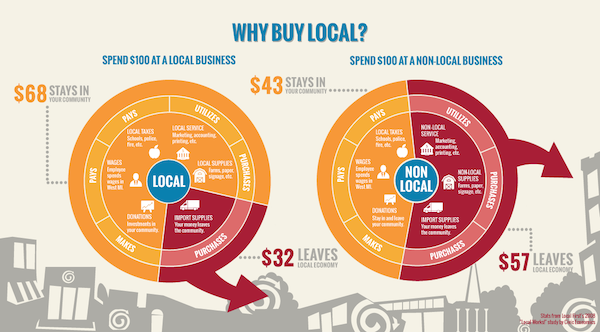
(Source: Business Alliance for Local Living Economies.)
To view a larger version of the “Who Owns Organic” chart featured at the top of this post, click here.
